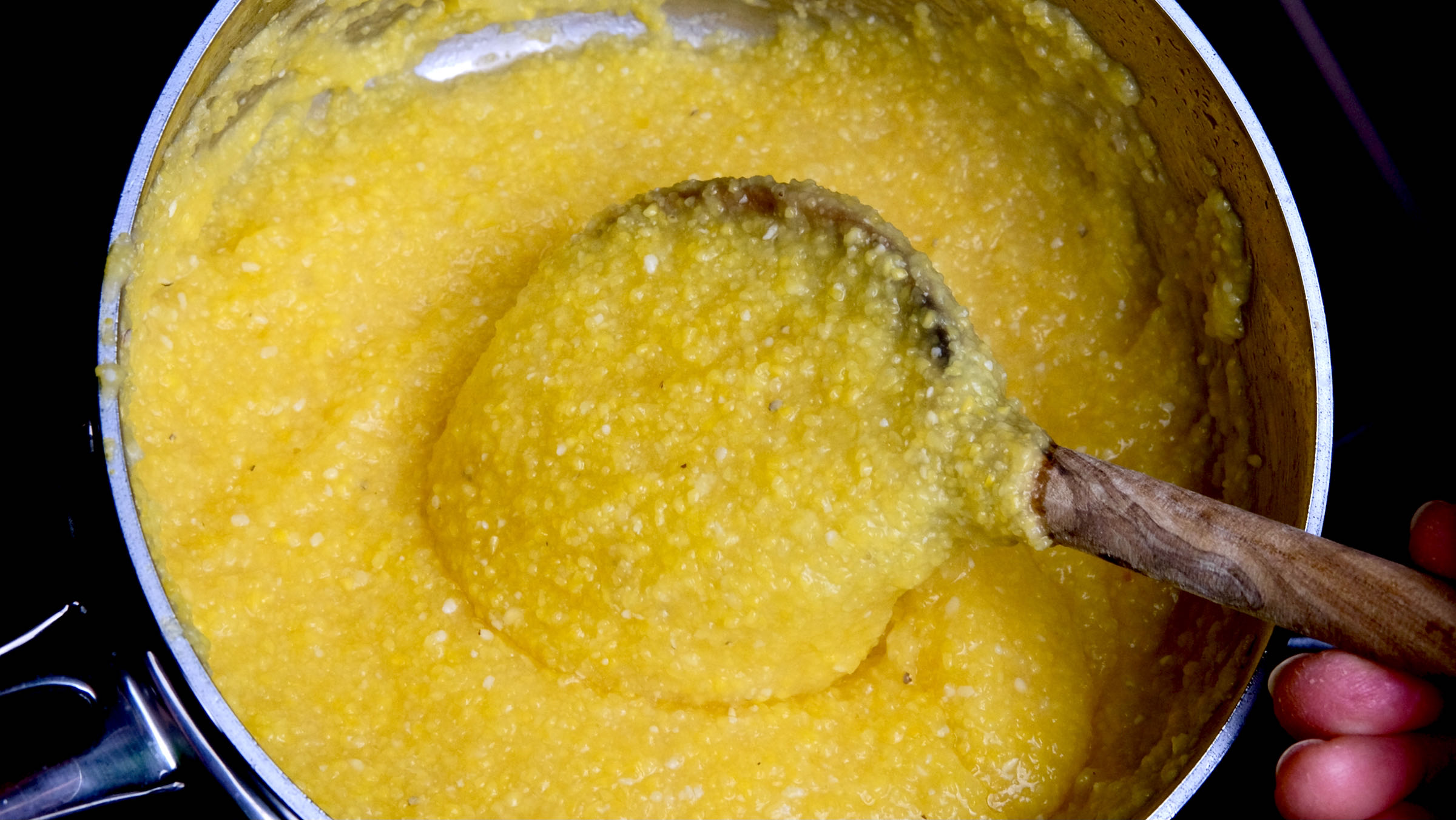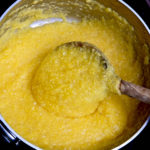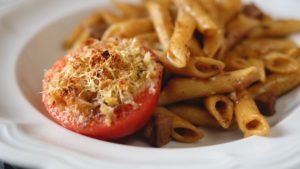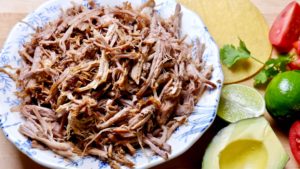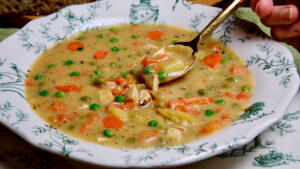With these these 5 easy steps anyone can make basic polenta. This creamy Italian staple is the basis for many dishes. Yet one thing I love about polenta is that it is a healthy alternative to pasta. Don’t get me wrong. Pasta is not a bad thing. However, if you are trying to maintain a whole grain diet, polenta is the perfect alternative to pasta.
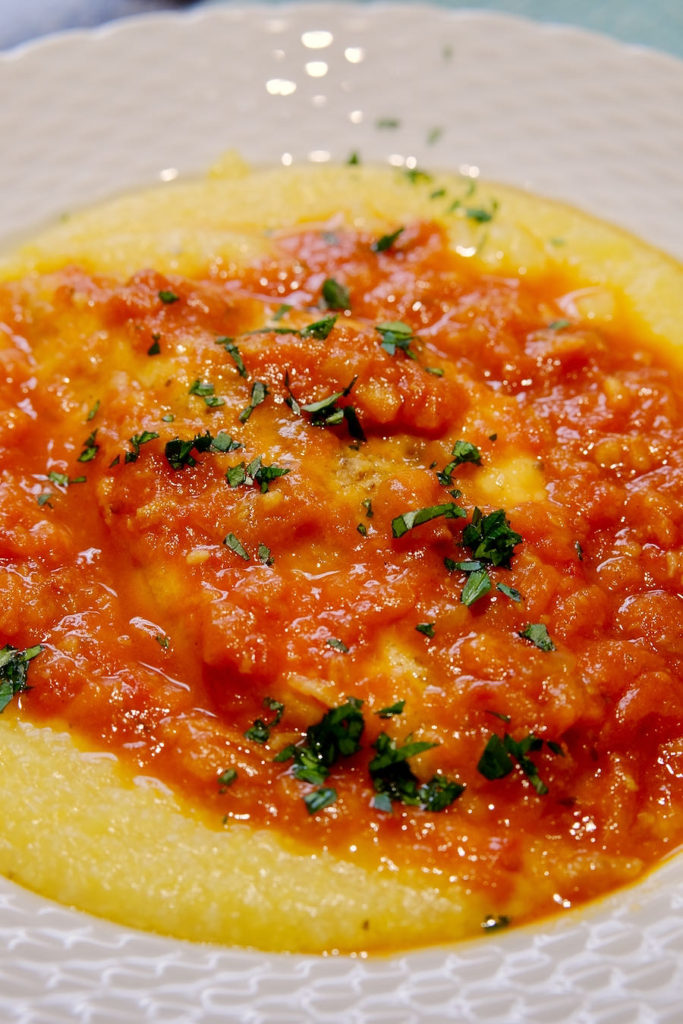
Polenta is a basic whole grain.
Polenta is a basic whole grain that can stand up to most any type of sauce. In fact, polenta will serve as a substitute almost anywhere pasta is used. And as polenta is gluten-free it is the perfect substitute for those who are gluten intolerant. Furthermore, as polenta is a whole grain, its a healthier alternative to pasta.
There are a number of different brands available, but my favorite by far is Golden Pheasant. Not only is the brand consistent in quality, it is very inexpensive. Generally, I’m able to find this brand in supermarkets like Von’s or Albertsons at a cost of $2.99 for a one pound bag. Additionally, some Italian markets carry it as well. In a pinch, cornmeal can be used as a replacement for polenta, as they are one in the same. Basically, the difference is the size of the grind.
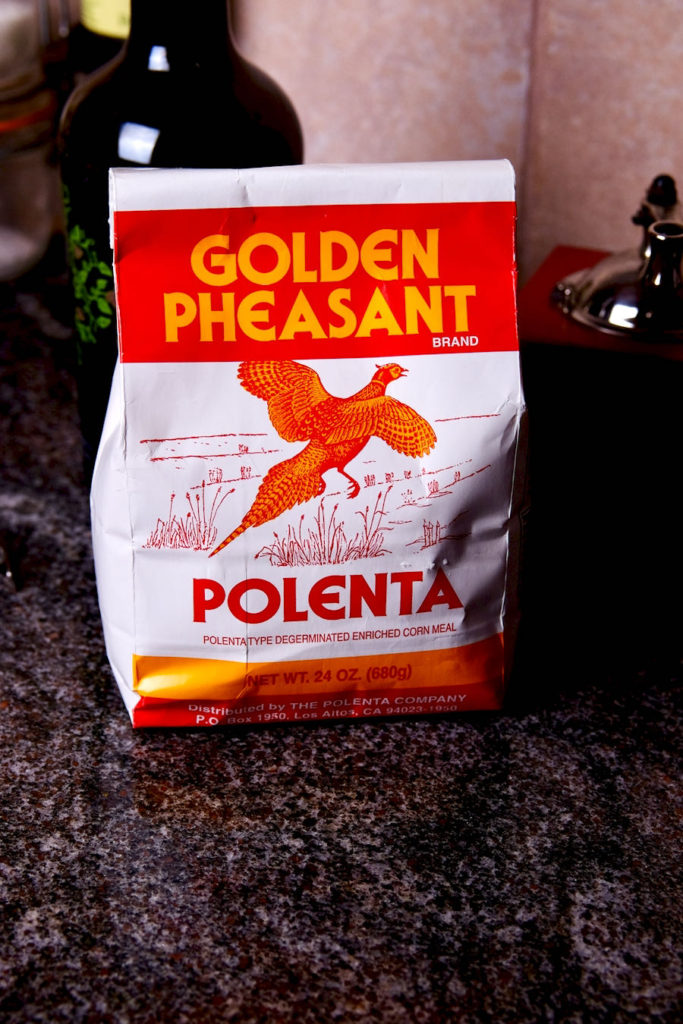
Prepared vs. fresh
First of all, let’s talk about prepared polenta. As I’m sure most of you have seen this stuff in the market. Why on earth would anyone be drawn to this hard lump of polenta rolled up like a big salami wrapped in plastic. Especially as polenta is so easy to make fresh and at a fraction of the cost. Also, when you make your own polenta, there are no additional additives like fats or preservatives. That is not unless you want to add butter or oil. But that is a different story. So pull out the pan and let’s get cooking with these easy to follow steps to perfect polenta.
Uses for Basic Polenta
Polenta for Dinner
For a quick and easy dinner, serve polenta with a basic tomato sauce. For a complete entree, consider polenta served along with Chicken Cacciatore, Short Rib Ragu or a Bolognese Sauce. If you are looking for a meatless entree, one of my favorites is polenta served with Mushroom Tomato Ragu. (Recipe coming soon!) Additionally, polenta can be use to make casserole dishes like tamale pie. Or consider serving your favorite chili recipe over polenta, rather than serving it with cornbread.
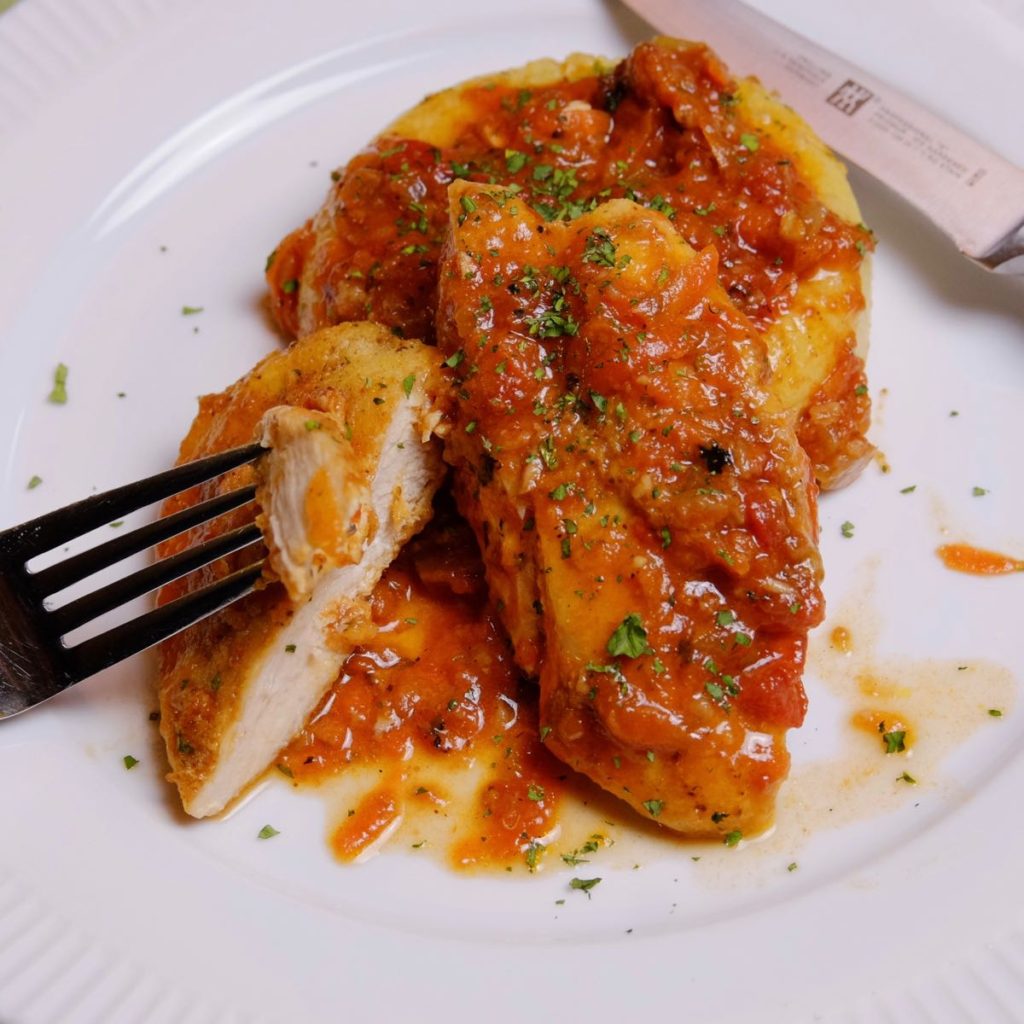
Polenta for Breakfast or Brunch
Have you ever considered polenta for breakfast? First of all, polenta is a lot like grits. The origin for grits is white corn, while polenta comes from yellow corn. And depending on the manufacturer, polenta may be slightly finer in texture. If you are looking to eat more whole grains, consider polenta as a hot breakfast cereal. You will find that it’s quite delicious with a little maple syrup. Or perhaps you would enjoy a bowl of warm polenta served with Sauteed Cinnamon Apples and toasted walnuts or pecans.
Additionally, you will find left over polenta makes a great breakfast staple. When I’m preparing my polenta, I immediately turn out the unused portion into a lightly oiled container. As the polenta cools, it becomes firm and solid. When ready to use, simply turn the polenta out onto a board and slice. For a quick and easy breakfast, saute slices of polenta in olive oil and serve with eggs. Add a slice of bacon or breakfast sausage and you have a breakfast fit for a king! As polenta and eggs are one of my husband’s favorite breakfasts, leftover polenta is coveted in our home.
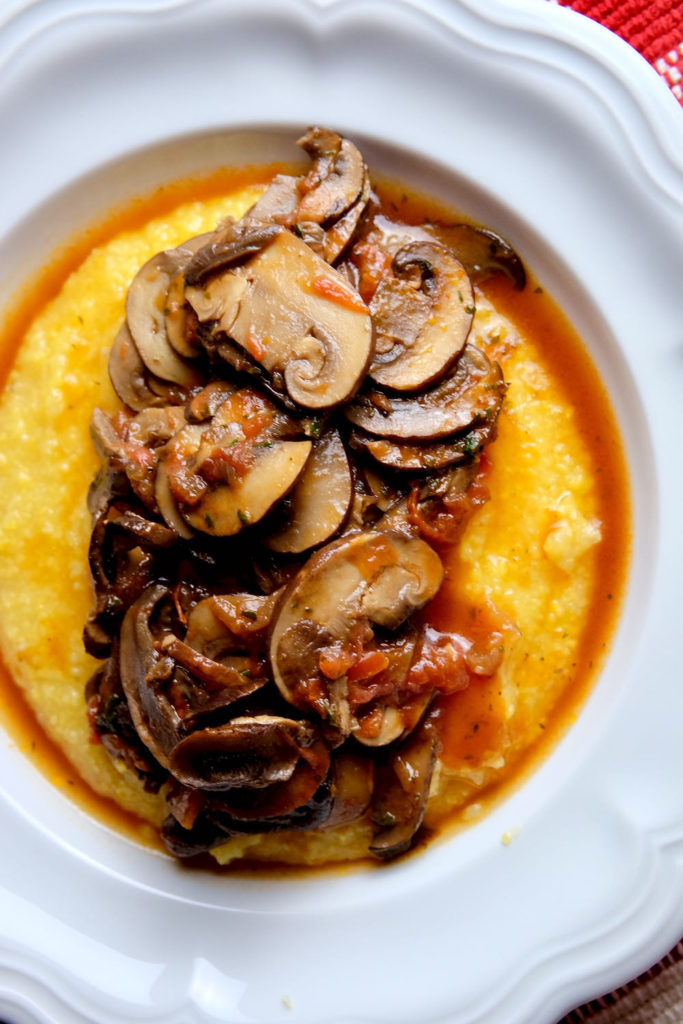
Make basic polenta in 5 Easy Steps
The Ingredients
To make polenta in its most basic form requires nothing more than water or broth, salt, polenta and a splash of olive oil. Basically, the liquid ratio for polenta is 4 to 1, meaning 4 cups of liquid to 1 cup of grain polenta. Additionally, a 1/2 teaspoon of salt is need for every cup of grain used, as well as a drizzle of olive oil. For perfect polenta, follow these basic steps. It isn’t necessary to add a lot of fat to make delicious polenta. A teaspoon or two of olive oil or butter is more than enough to add a pop of additional flavor and creamy texture. However if calories are of no concern to you feel free to add as much butter or oil to your polenta as you like.
Five Simple Steps to Basic Polenta
- Bring liquid to boil over medium high heat. The rule of thumb for basic polenta is 4 cups of liquid to 1 cup of dry polenta. The liquid may be all water, all broth or a combination of both. When choosing a broth for cooking, consider the dish it will be served with. For instance, if you are looking for a meatless dish choose vegetable broth or water. If Chicken Cacciatore is being served, you may wish to use chicken broth.
- Turn the heat off and while stirring the liquid, slowly pour in the polenta and salt.
- Return pan to medium-low heat and continue to cook polenta while constantly stirring, about 10-12 minutes.
- As the polenta cooks, it will slowly begin to thicken. When the polenta begins to reach the consistency of peanut butter it is nearly finished. Add a drizzle of olive oil, about 1 teaspoon per cup of dry polenta and continue to cook while stirring about 2-3 additional minutes. (If you prefer, butter may be substituted for olive oil.)
- When the polenta begins to pull away from the sides of the pan, it is finished. Notice that when the spoon is pulled through the polenta, it leaves a path. Another test that was passed on by my mother-in-law is the standing spoon. If the spoon will stand up in the polenta, it is finished. It’s time to plate and enjoy your polenta
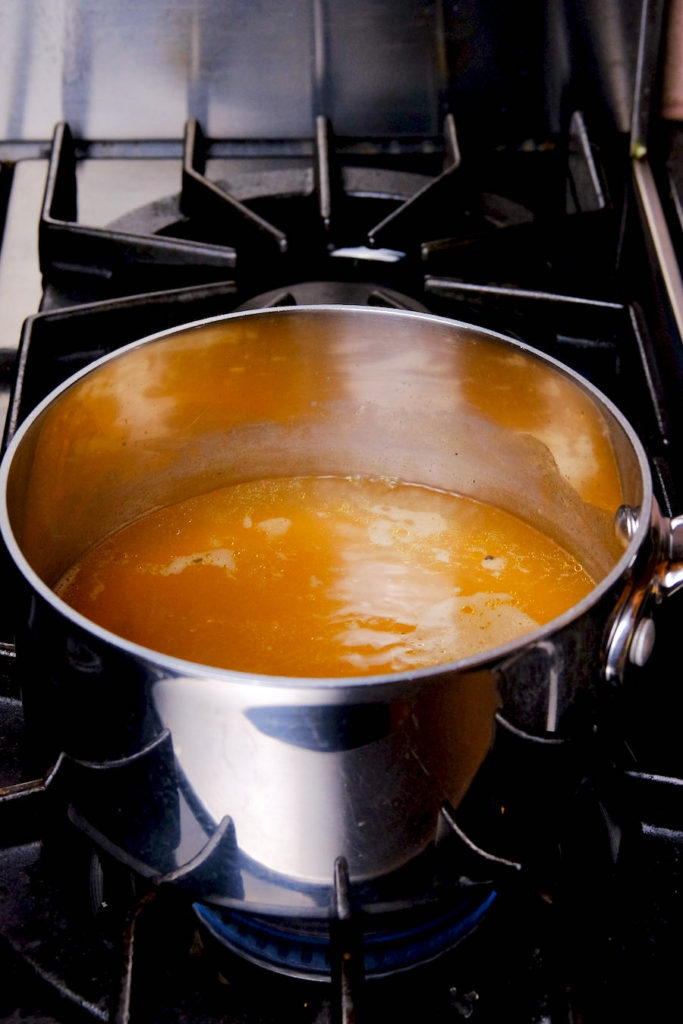
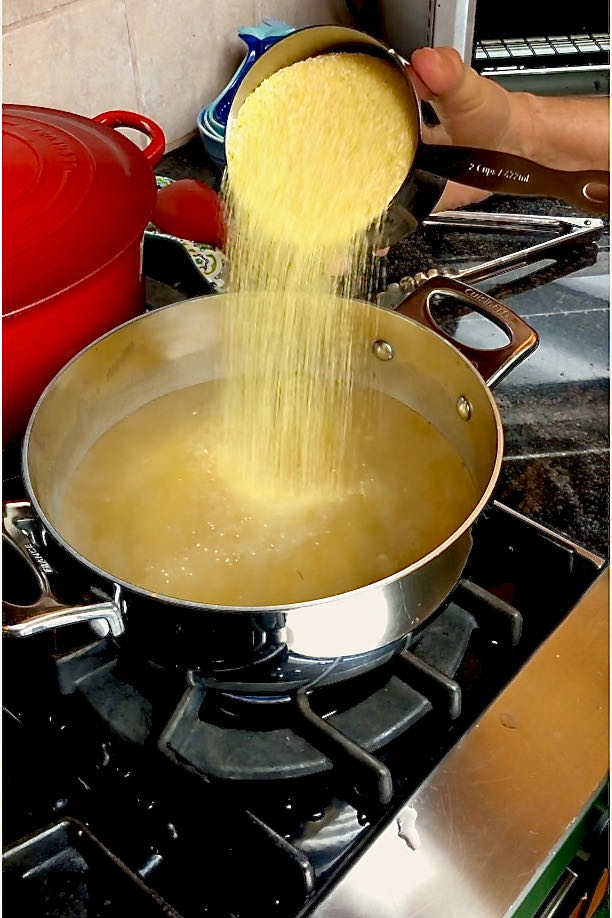
constant stirring is key.
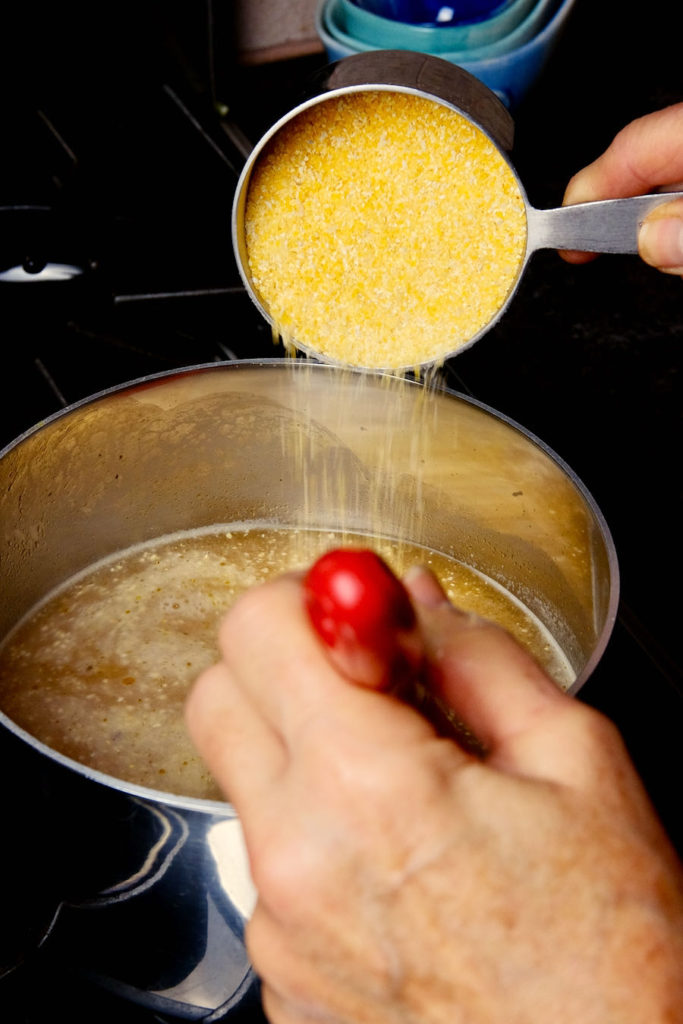
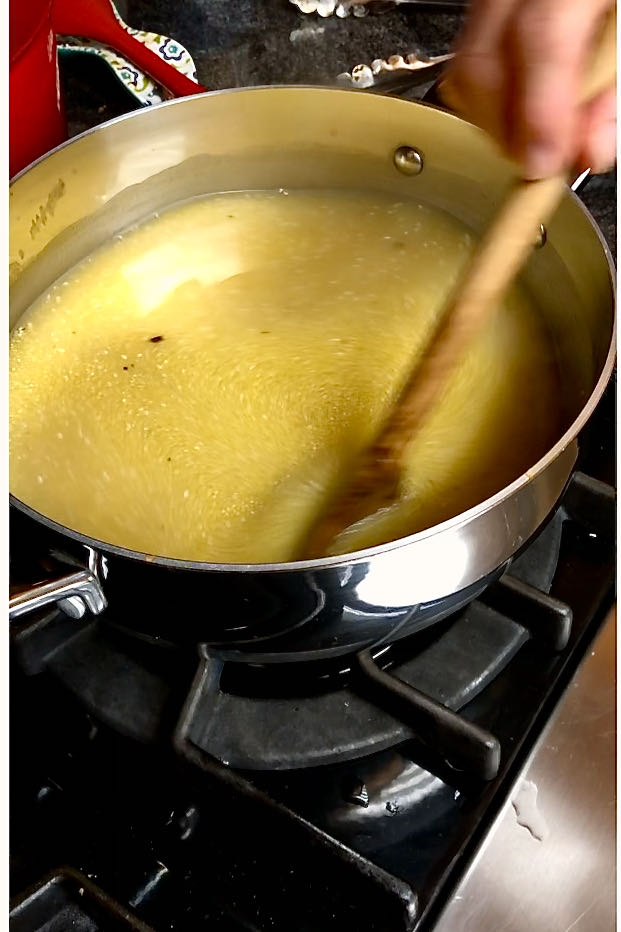
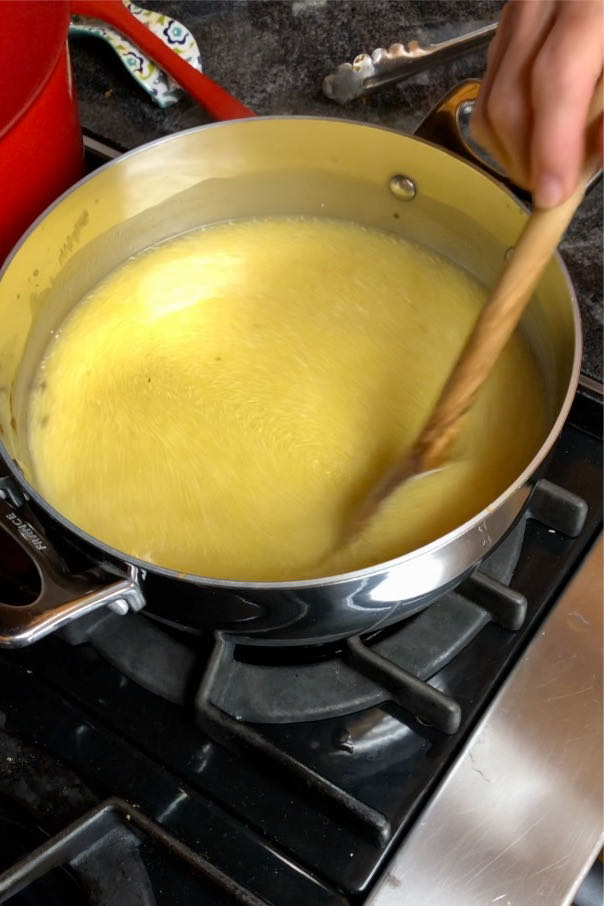
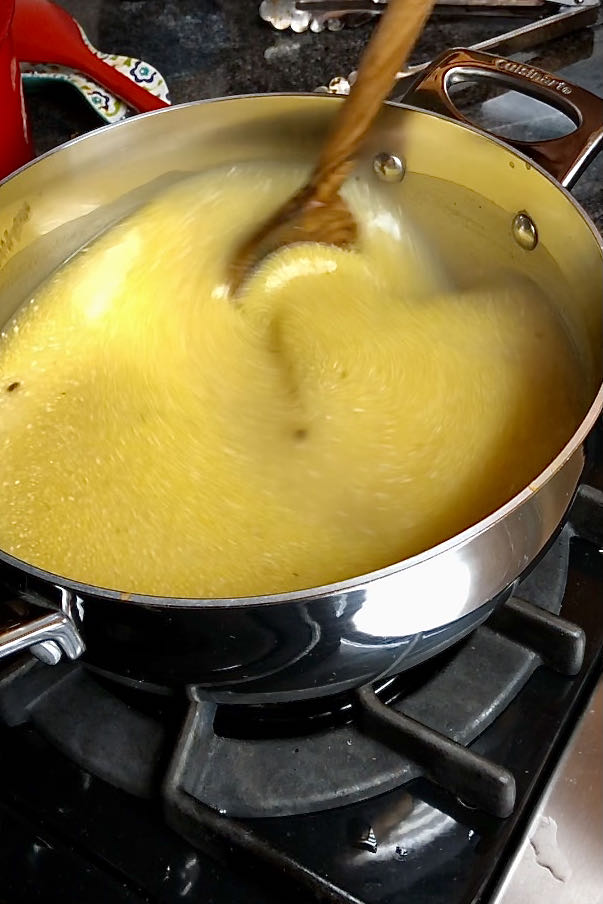
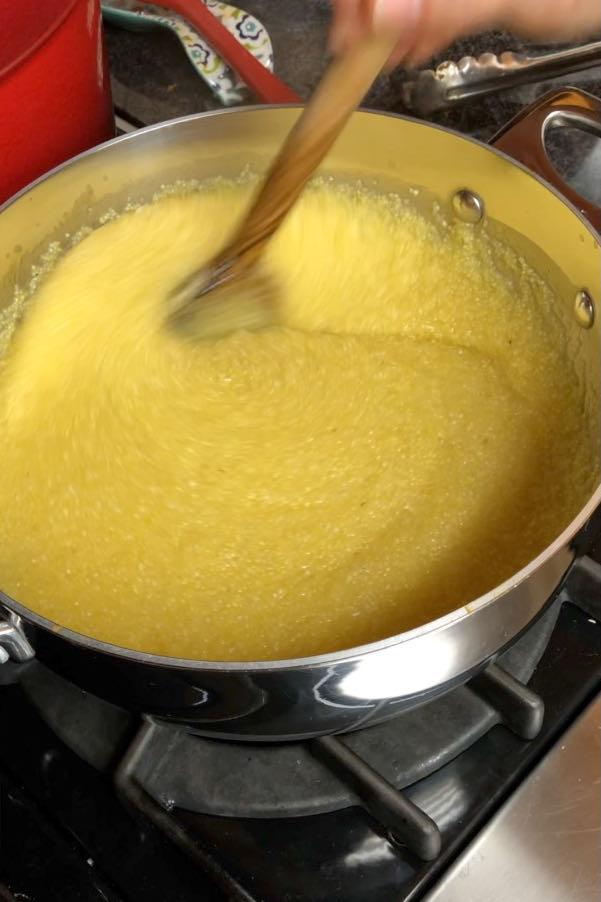
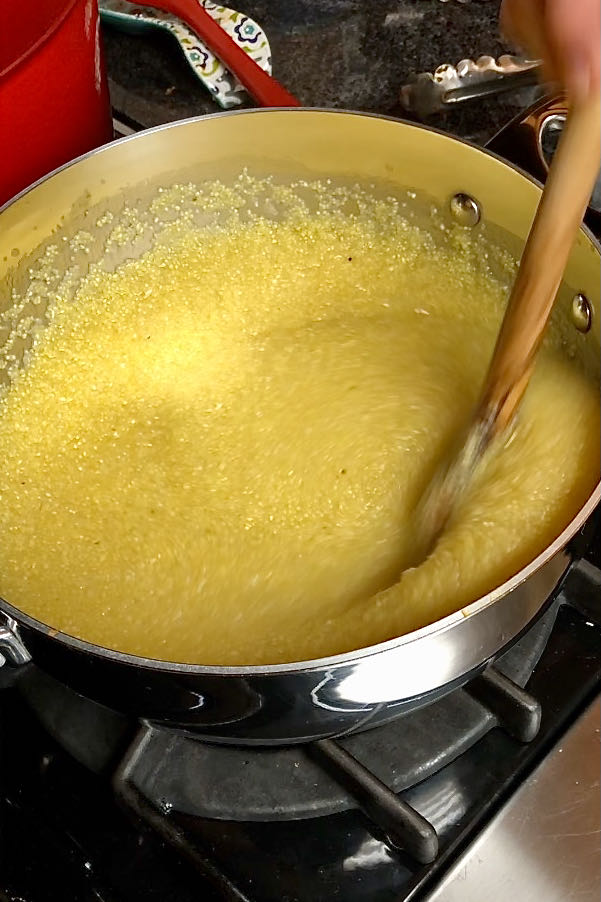
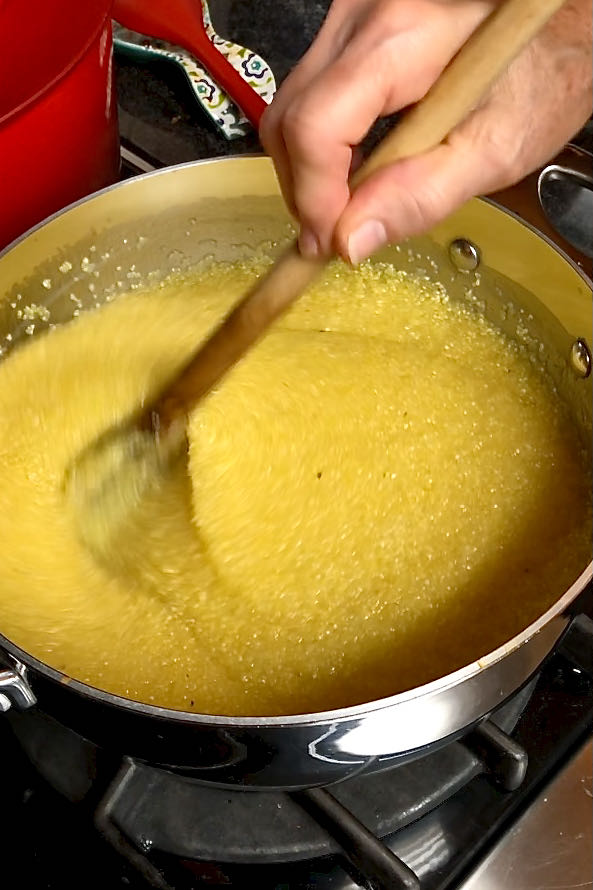
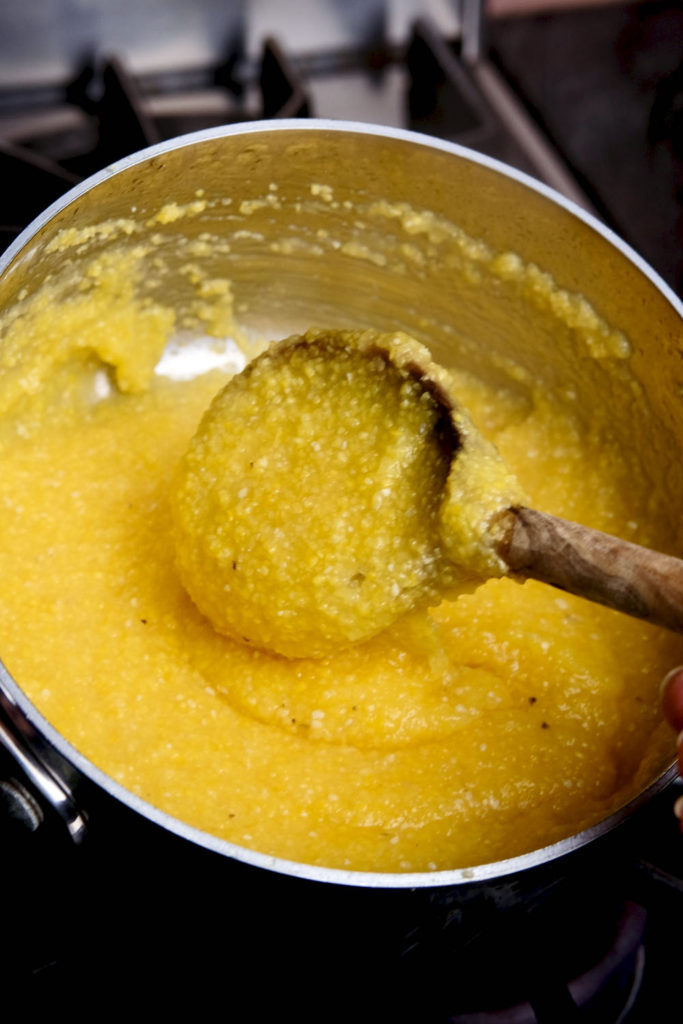
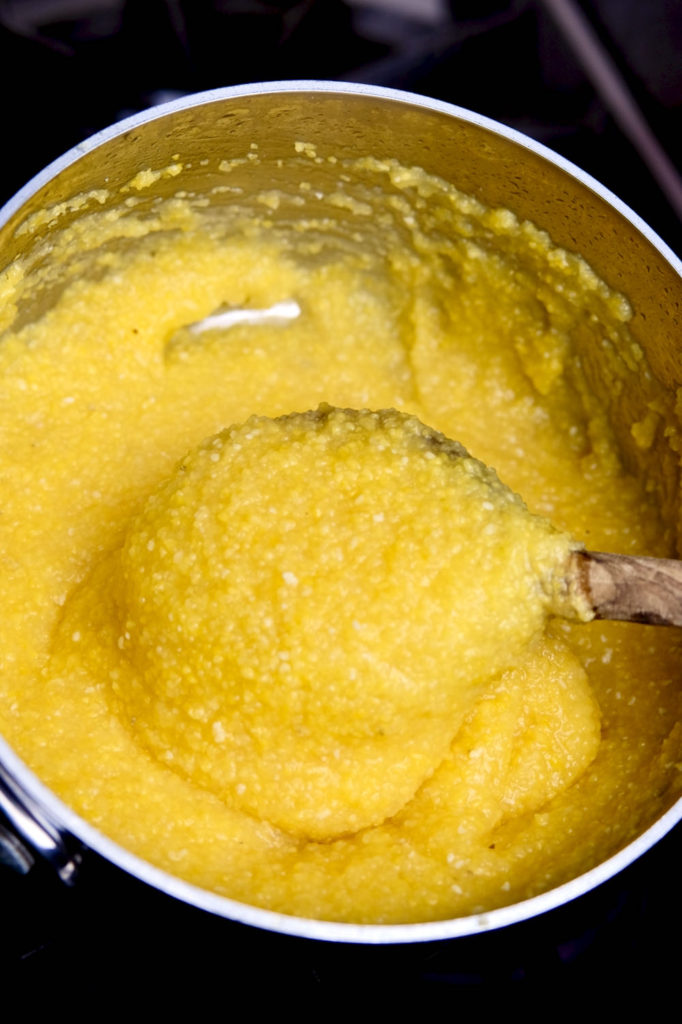
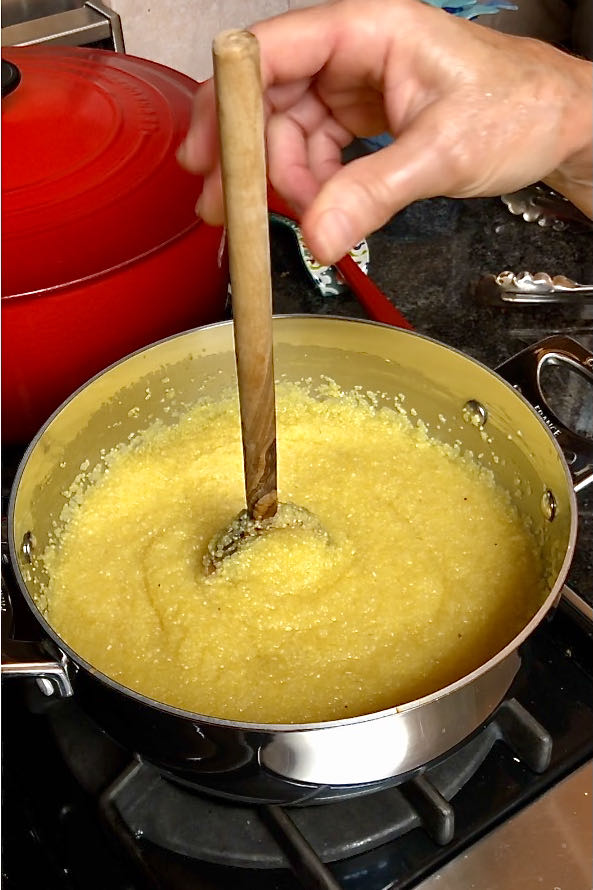
Another way to tell if polenta is cooked to the desired consistency ….
The standing spoon test.
Easy Steps for Leftover Polenta
As polenta will begin to firm as it cools, it becomes difficult to form after the meal is finished. For this reason, I dish up individual servings for the meal and immediately place the remainder in a sealable container. When the polenta is warm it is pliable and easy to form. If someone desires an additional serving, it can be spooned out of the container. Even though it has begun to set, you will still find it delicious.
Tips for keeping it simple
To help keep it simple, I find that it is easiest to have a lightly oiled container ready before I begin to plate servings. This allows me to pour the left over polenta into the storage container immediately. Also, I would like to make a suggestion for easy clean up. After removing all of the polenta from the pan, immediately take the pan to the sink and fill with warm water. This step will eliminate the need for soaking the pan later.
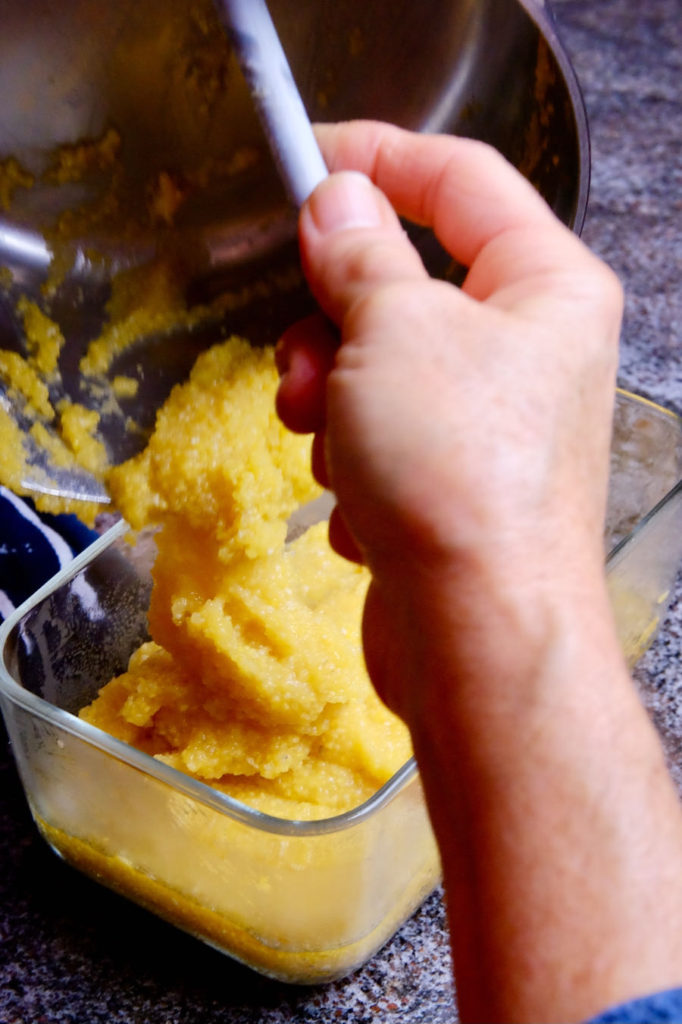
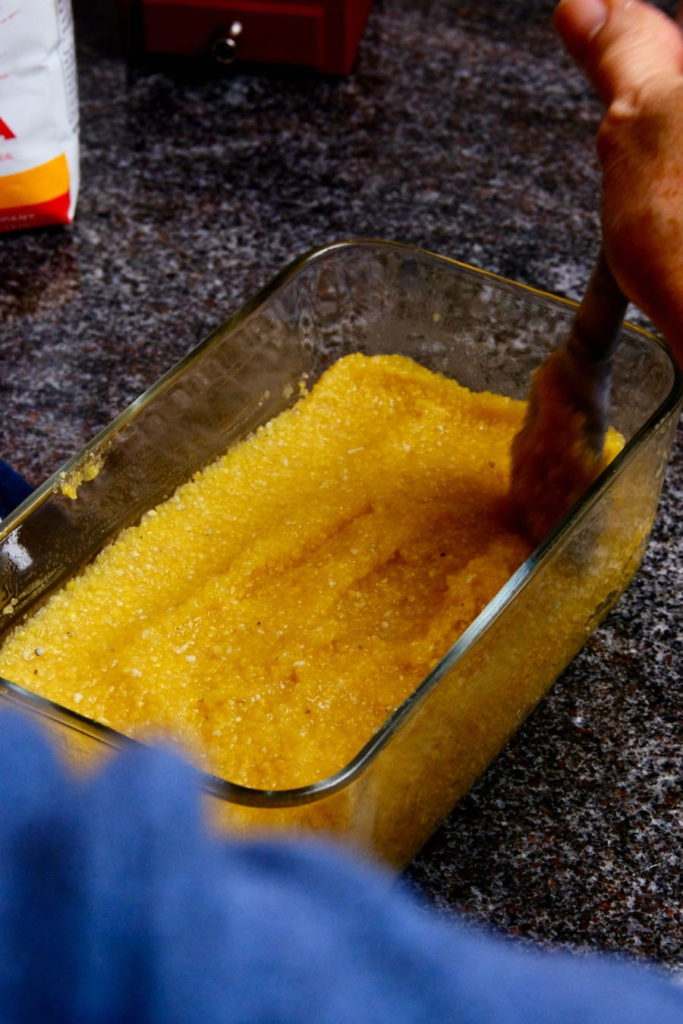
- Select the container for storage and slightly oil the bottom and sides. A few drops of olive oil will do the trick. Simply rub the oil around with your fingertips. (Also, it doesn’t matter on the shape of the container. If you choose a round container, the polenta slices will be disc shaped. If you choose a square or rectangular container, the polenta slices will be more squared.)
- Prepare individual servings.
- Immediately pour leftover polenta into oiled container and smooth with a spatula.
- Take empty pan to sink and fill with warm water.
- Go sit down and enjoy your dish of polenta!
Weight Watchers and Waist Watchers
A 3/4 cup serving of cooked polenta is 4 WW Smart Points or 104 calories.
A 1 cup serving of cooked polenta is 5 WW Smart Points or 130 calories.
Buon Appetito!
PrintEasy Steps to Make Basic Polenta
Basic polenta is a whole grain that can be used with almost any sauce and served with dishes like Chicken Cacciatore, Short Rib Ragu or Mushroom Tomato Ragu. Not only is polenta a healthy alternative to pasta but it can be used to make casseroles like tamale pie. Cut leftover polenta into slices and quickly saute in olive oil for a healthy breakfast alternative that can be served with eggs.
- Prep Time: 2 minutes
- Cook Time: 10-15
- Total Time: 17 minutes
- Yield: 4 Cups 1x
- Category: Entree
- Method: Stove Top
- Cuisine: Italian
Ingredients
- 4 cups Stock, Broth or Water (Or use a combination of both broth and water)
- 1 cup Dry Polenta
- 2 teaspoons Olive Oil
- 1/2 teaspoon Kosher Salt
Instructions
- Bring liquid to boil over medium high heat. The rule of thumb for basic polenta is 4 cups of liquid to 1 cup of dry polenta. The liquid may be all water, all broth or a combination of both. When choosing a broth for cooking, consider the dish it will be served with. For instance, if you are looking for a meatless dish choose vegetable broth or water. If Chicken Cacciatore is being served, you may wish to use chicken broth.
- Turn the heat off and while stirring liquid, slowly pour in the polenta and salt. This step will keep the water from boiling over.
- Return pan to medium-low heat and continue to cook polenta while constantly stirring, about 10-12 minutes.
- As the polenta cooks, it will slowly begin to thicken. When the polenta begins to reach the consistency of peanut butter it is nearly finished. Add olive oil and continue to cook while stirring, 2-3 more minutes. (If you prefer, butter may be substituted for olive oil.)
- When the polenta begins to pull away from the sides of the pan, it is finished. Notice that when the spoon is pulled through the polenta, it leaves a path. Another test that was passed on by my mother-in-law is the standing spoon. If the spoon will stand up in the polenta, it is finished. It’s time to plate and enjoy your polenta.
Notes
* See my notes above for storing leftover polenta.

